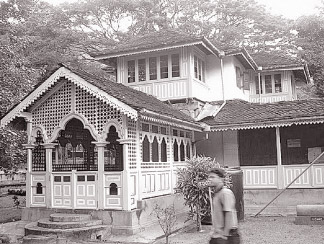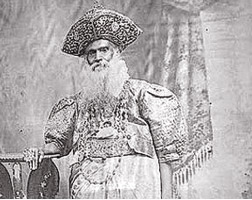|
Maduwanwala:
Fabulous abode of a chieftain of wilderness
By Amal HEWAVISSENTI
Without a shadow of doubt, Maduwanwala Walawwa is a wonderful place
that reflects almost three centuries of admiration from all generations
in Sri Lanka. The identity of Maduwanwala shot up to widespread fame
when Wijesundara Ekanayaka Abayakoon Mudliyar, the forerunner of
Maduwanwala generation presented a rare white stag alive to the Kandyan
King around 1700 AD and was gifted with a vast tract of land that is
called Maduwanwala today.
|

Maduwanwala Walawwa |
The most spectacular feature of the Walawwa that strikes a sense of
wonder and admiration into the mind of a visitor is the arch of cut
granite set in the stone entrance facing Embilipitiya - Sooriyakanda
main road. The stone entrance of an imposing shape reflects Maduwanwala
Disawe's highly refined taste for traditional art and is a clear
statement of his pride as a powerful chieftain. The impressive edifices
and massive trees towering to great heights are reminiscent of the
provincial royal power that once reigned supreme in the Kolonna Korale's
of Sabaragamuwa Province. Maduwanwala Disawe (James William Maduwanwala)
was practically the symbol of undisputed political power and the man who
rather despotically determined everything of his people. It is probably
best to say that he recast the social and cultural map of the people
under his leadership.
The place
|

Maduwanwala Disawe |
Maduwanwala is a complex of buildings totally proto typical of the
palace of the Kandyan King. With its exquisitely crafted stone and wood
decorations, the building is a surprising architectural arrangement of a
shrine room, a tribunal, pirith mandapa, armoury, store rooms for
liquor, food and meat, dancing room, different kitchens, labour room,
granaries and many more buildings for varied purposes. The place itself
was an art gallery with local and foreign furniture exquisitely crafted
out of ebony, nedun, satinwood and teak by the best carpenters and
carvers of the time. Among the furniture were some superbly exotic
furniture gifted to him by amiable English officials. There was a
special hall for training untamed elephants (Ali Panthiya) and a few
stables for horses. On the main court were two huge guns placed on a
platform which fired 21 cannon balls to welcome royal guests who arrived
at the Walawwa.
It is interesting to observe that imported cups, plates and other
utensils had been produced in England with the emblem of a Stag's head
with a branched antler. The practice of marking plates, cups and
letterheads with a Stag's head was to commemorate the presenting of the
white Stag to the King by the first Maduwanwala, the founder of the
place. R. L. Spittel, who noted the gradual decline of Walawwa and its
premises from its pristine grandeur during the last days of Maduwanwala
Disawa, said.
"A paved way, long neglected, ran from the granite arch towards
Walawwa. The two rows of damaged posts stood unstable on either side.
Great trees rose up threateningly against any harm to the building. What
struck my mind was the giant Bo tree surrounded by a short wall with
fragmented votive lamps. There were faded flowers on the stone altar."
Who was Maduwanwala
The last of the generation of Maduwanwala, James William Maduwanwala
was born on 11th Sept. 1844. He had his primary education at S. Thomas'
College, Colombo where he mastered the English language and got the
basic training to rub shoulders with English officials in possession of
much of the political power then. Be that as it may, he discontinued
school education for some unexplained reasons and returned to his
village to take possession of the control of people living in his
father's 'mini kingdom' in Sabaragamuwa. Young Maduwanwala preferred
sipping whisky and horse riding and was frequently seen riding a horse
to Ratnapura on his official visit to the Government Agent, an
Englishman. Maduwanwala, who possessed a remarkable fluency in English,
often spoke fluent English with the Governor who felt compelled to give
Disawe the title "Sir James William."
An extraordinary amount of legal power was vested in him by tradition
enabling him to discharge public duties and to keep the wheel of justice
in motion. He possessed a well-organised battalion and was a loose
cannon to mete out punishment (except for capital punishment) on all
offenders within his territory of control. In the view point of English
officials, Maduwanwala was comparable to a knight in medieval England.
He was attractively slender and graceful with long white beard which
added to the customary elegance of a chieftain. Though he was old, he
displayed an augustly dignified in impressive personality and was the
only chieftain who could maintain many elephant kraals without the
permission of the Government.
During 1880s there was virtually no limit to what young Maduwanwala
achieved because of the fantastic support and respect he commanded from
his people on his law-abiding nature, outspokenness, and skills in
management. He had the practice of inviting all the people of his
territory for the new year and treating them continuously with gifts and
food for three days. At the same time, his wickedly off-beat frame of
mind to keep his people under tight rein is sometimes surprising.
The English Governors Herbert Wace, Sir Arthur Hamilton Gordon, Sir
Joseph West Ridgeway were those higher officials who paid formal but
friendly visits to him. Once he was invited to a grand function at the
Governor's mansion in Colombo. As Maduwanwala unabashedly overlooked the
invitation, the Governor sent him a message which said the Governor was
not to invite Maduwanwala Disawe for anything in his mansion thereafter.
To this, Maduwanwala calmly informed him that the Governor's decision
was to his immense pleasure and advantage because he would not have to
taste the low "quality mixed champaign."
Amusing events
Maduwanwala Disawa is generally known to have valued punctuality and
almost every visitor to his abode was overwhelmed by the extravagant
hospitality that he evinced. He hated weak promises. Once the white
Agent of Ratnapura had informed him of an intended formal visit to his
walawwa on an official duty. Here, Maduwanwala Disawe made the grandest
arrangement of food and everything for the Agent and his horse, but to
his utter disappointment, the Agent did not turn up for some reason.
But two days later, the white Agent arrived at Maduwanwala and
dismounted declaring himself the Agent of Ratnapura. In fluent English,
Maduwanwala expressed his "mistrust" of the "white man." "You're lying.
You're not the Agent. He promised he'd come yesterday. Hey boys! tie
this lying man, to that Mara tree."
The Agent was kept for around six hours tied to the tree and was sent
back even without anything to drink. Shocked and enraged by this blatant
insolence, the white Agent sent a gang of fully armed, rowdy vandals to
plunder and destroy Maduwanwala's abode. Maduwanwala, who had
preconceived notions of Agent's action, instructed his men to organise a
grand banquet with lots of whisky and hide themselves around the house.
The whiteman, finding none in the Walawwa, instantly enjoyed the food
mixed with cannabis and whisky because they had travelled a long way.
Intoxicated, the English men lay sprawled snoring here and there. After
few hours, the men carried the intoxicated white men out of the walawwa
and abandoned them in remote jungles. The following day, the white men
had to force their way through the jungle and inform the English
Governor of what had happened.
"He is a strange man. Don't play with him." This was the Governor's
reply. If we are to remove the threads of exaggeration in this story and
the like, it becomes clear that Maduwanwala was a law-abiding, punctual
man. But he became a law unto himself when it came to the irreconcilably
prejudiced white officials against innocent people.
Othelluse the Dutch robber
Othelluse was a dutch robber who was infamous for torture, plunder
and was notoriously difficult to manage. One day Maduwanwala Mohottala,
the forefather of Maduwanwala Disawe made plans, together with his men,
to trap Othelluse and kill him because he was a constant annoyance even
to the King. Mohottala, disguised as a bride, was travelling in the
thick jungles of Panamura with his men playing drums and making noises.
Othelluse flew into a fit of rage on seeing people and they, as
instructed, fled indifferent directions leaving behind Maduwanwala
Mohottala, still disguised as a bride. Othelluse, tempted by the
strongest desires, did not hesitate to embrace the "woman" and carry her
into the jungle. Mohottala promptly drew out his concealed sword and cut
his head. The King Narendrasinha, absolutely satisfied, decorated
Mohottala's Knightly arts of battle and granted him land (Nindagama) by
a Sannasa (a proclamation).
Last days
It is said that during his last days, he was bedridden with incurable
injuries on the foot and arrangement were made to bring the famous
doctor R. L. Spittel from Colombo to attend to his condition. In his
diary, Spittel says "I protested a surgery on him because of his age and
fragile health. Yet this brave Sinhala man insisted on it. He incredibly
bore up with the pain as I did not anaesthetize him. I managed to
sustain his life for two or three weeks more." He died on Sept. 6, 1930
at the age of 86.
Ceylon Observer's condolence
"Death of Maduwanwala R. M. organiser of many Elephant Kraals."
The death of Mr. J. W. Maduwanwala, the veteran Kandyan Chief, at the
ripe age of 86 years, removes one of the best known figures in the life
of Sabaragamuwa. It is many years since the late Mr. Maduwanwala who was
one of the biggest land owners in the Kandyan Provinces retired from the
Ratemahatmayaship of Kolonna. His great influence in his district,
however, lasted till the day of his death. To the present generation,
Mr. Maduwanwala was best known as the organiser of many successful
elephant Kraals at Panamure and elsewhere which successive Governor made
a point of attending.
Mr. Maduwanwala was a man of great independence of character and was
popular wherever he was known. Mr. A. F. Molamure who represent the
Kegalle district in the Legislative Council is a nephew of the Late Mr.
Maduwanwala."
(From the morning edition of Ceylon Observer 7 September 1930).
|

